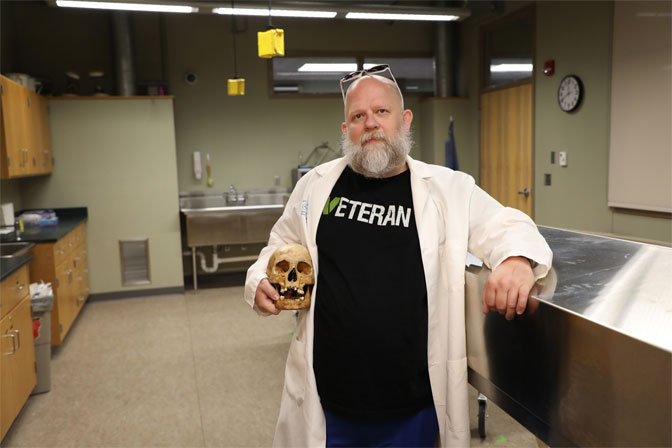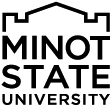
Serious with a side of silly putty
MINOT, N.D. – Nestled in between anatomy books, a wall of diplomas, and a handbook for medical soldiers in World War II, Aaron Ament’s office is full of superhero toys and Legos.
“One thing I asked my wife for was a big old block of silly putty,” he said. “She ordered five pounds of it directly from the company.”
As biology lab instructor and cadaver lab supervisor at Minot State, as well as having an intense history as a medical doctor, Ament has plenty of reason to balance out the serious with play.
“I do have a need to decompress because sometimes it’s a bit much,” he said. “It’s pretty second nature to me at this point but there have been times when — I think it’s probably because of the number of things I’ve seen — that I’ll have a memory come back that I need to deal with.”
Ament enrolled in medical school in the mid-90s and found himself in Washington, D.C., Baltimore, and Chicago for most of his residency at a time when the AIDS epidemic was in full force, often serving in high-crime, downtown hospitals.
“It was only 10 years into HIV/AIDS and there was a lot of people who wouldn’t work with the patients. I worked in one of the really downtown, scary hospitals, and I mean scary because it was very routine to hear gunfire outside the hospital,” he said. “It was just the environment. We had a lot of patients that went to prison and we had a lot of patients with AIDS. That’s where I really saw the devastating effects of the disease at a time when there weren’t a lot of drug options.”
While Baltimore and Chicago offered a glimpse into physical maladies, his turn in the capital city opened his eyes to the world of psychiatry.
That rotation was spent at St. Elizabeths Hospital, founded in 1852 and the first federally-operated psychiatric hospital in the United States.
“I had never heard of it before, but it has been there since before the Civil War,” Ament said. “Now it’s what some people would call an insane asylum that’s still functioning. But it also has a prison on site and there’s a couple unique things about that place.
“One was the prison itself. Because it was on federal land it had lots of federal inmates that also needed psychiatric care.”
It was the inmates that intrigued Ament so he asked, and received, permission to spend four weeks working at the jail after finishing up his rotation at the regular facility. He was there at the same time as John Hinckley Jr., who shot President Ronald Reagan, and other high-profile federal offenders.
“All of those experiences, that’s what I try to bring to class,” he said.
Often ranked a favorite Minot State instructor, he connects with students by sharing his real-life experiences and humor in a serious, hands-on learning area on campus.
“It can get a little too personal,” he said about working in the lab. “But that’s something any student is going to have to slowly adjust to — there are things that will bother any doctor.
“I try and let them feel free to use a little dark humor but if they cross a line into disrespectful territory, I’ll back them off. I don’t fault them, because it’s the first time a lot of them are dealing with this, and they’re going to make mistakes. I try to make the lab a safe place to make mistakes.”
Ament ended up in Minot for his residency in family medicine, shortly before 9/11 occurred, which led to a career in the U.S. Air Force prior to his role at Minot State.
“Because I was on the cusp of graduating, there was a big push at the time to recruit as many doctors out of medical school as possible because they were anticipating a huge need, and I was a part of that,” he said.
During his time in the service, he found himself in different locations across the world, including a site shortly after a large volcanic eruption.
“I enjoyed my time. Those little excursions to do humanitarian care were some of the best experiences just because you could help the most people who obviously had the greatest need,” he said. “Yet, that was the place where I saw more of the horrific kid injuries, and people that had medical problems that have never been addressed.”
Knowing that medicine doesn’t follow a routine textbook, Ament finds purpose in instructing students.
“My biggest thing is, I don’t want you to fill in a list of things you have to memorize for a test with no real clue why you need to know it,” he said. “My goal is really to try and make it not only real for them, but also give them the real benefit of doing something they can feel.
“Traditionally, when you learn a subject you have a book and everything is very generic. But life isn’t generic.”
About Minot State University
Minot State University is a public university dedicated to excellence in education, scholarship, and community engagement achieved through
rigorous academic experiences, active learning environments, commitment to public service, and a vibrant campus life.
Published: 06/28/21




